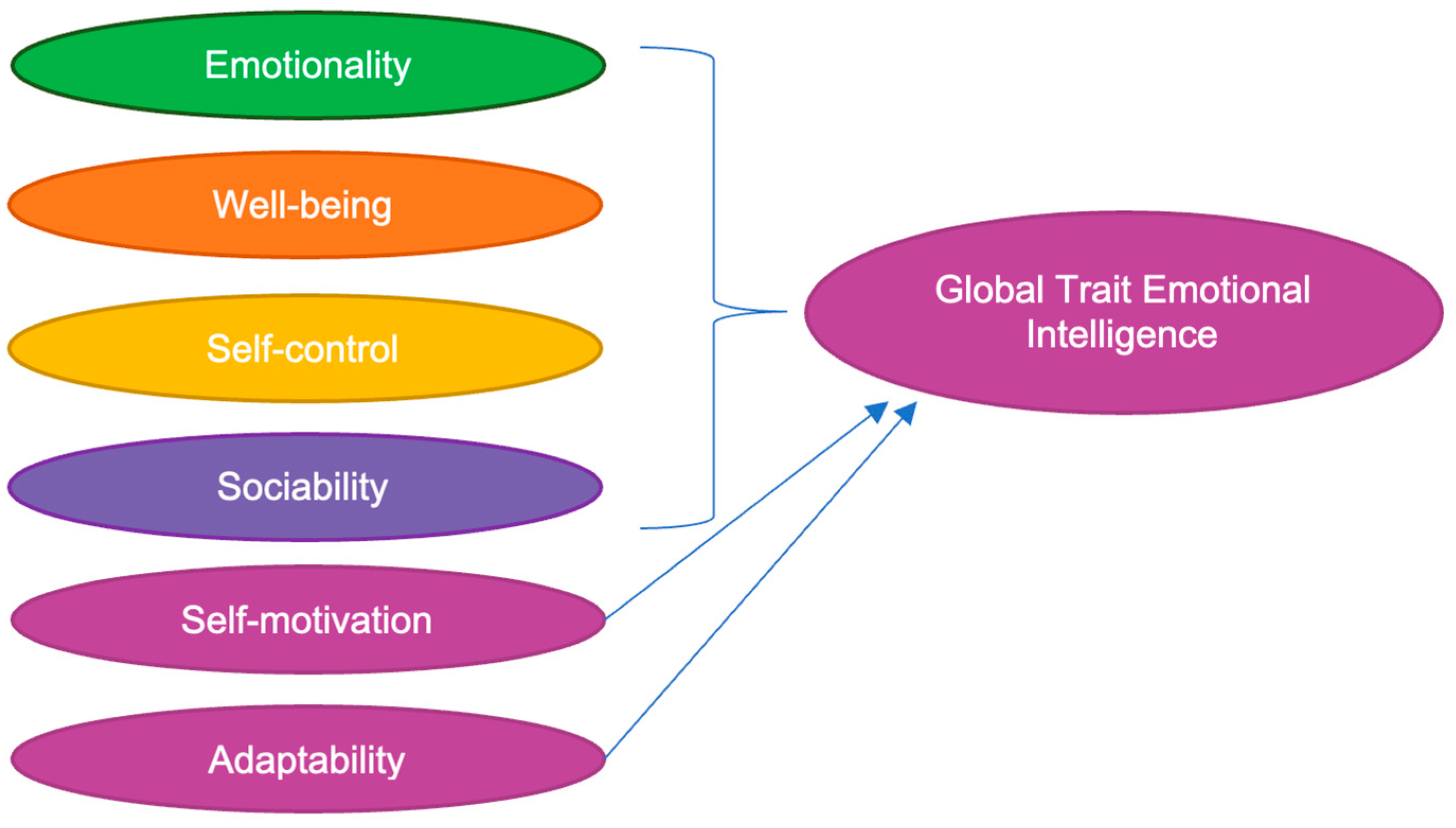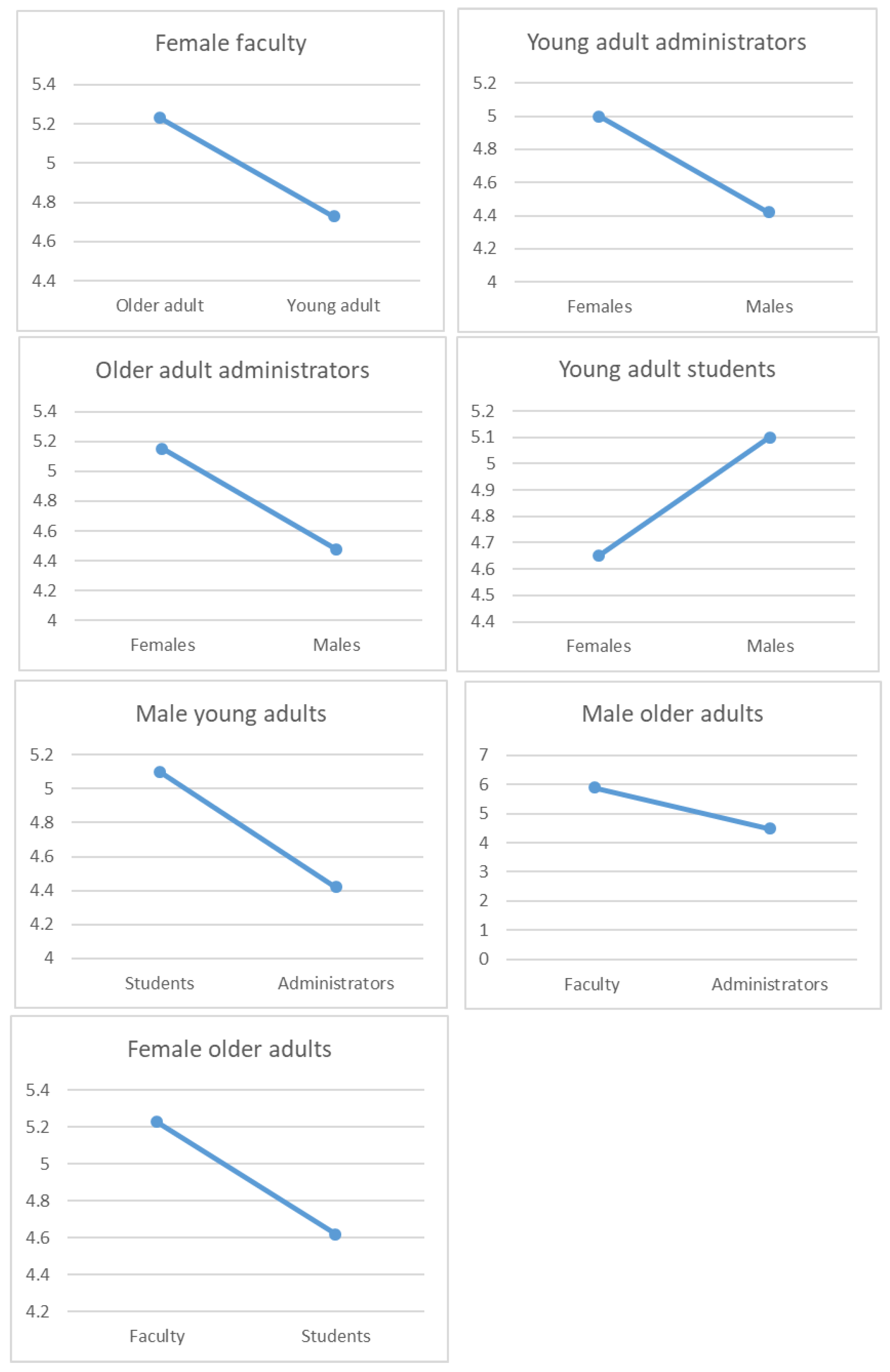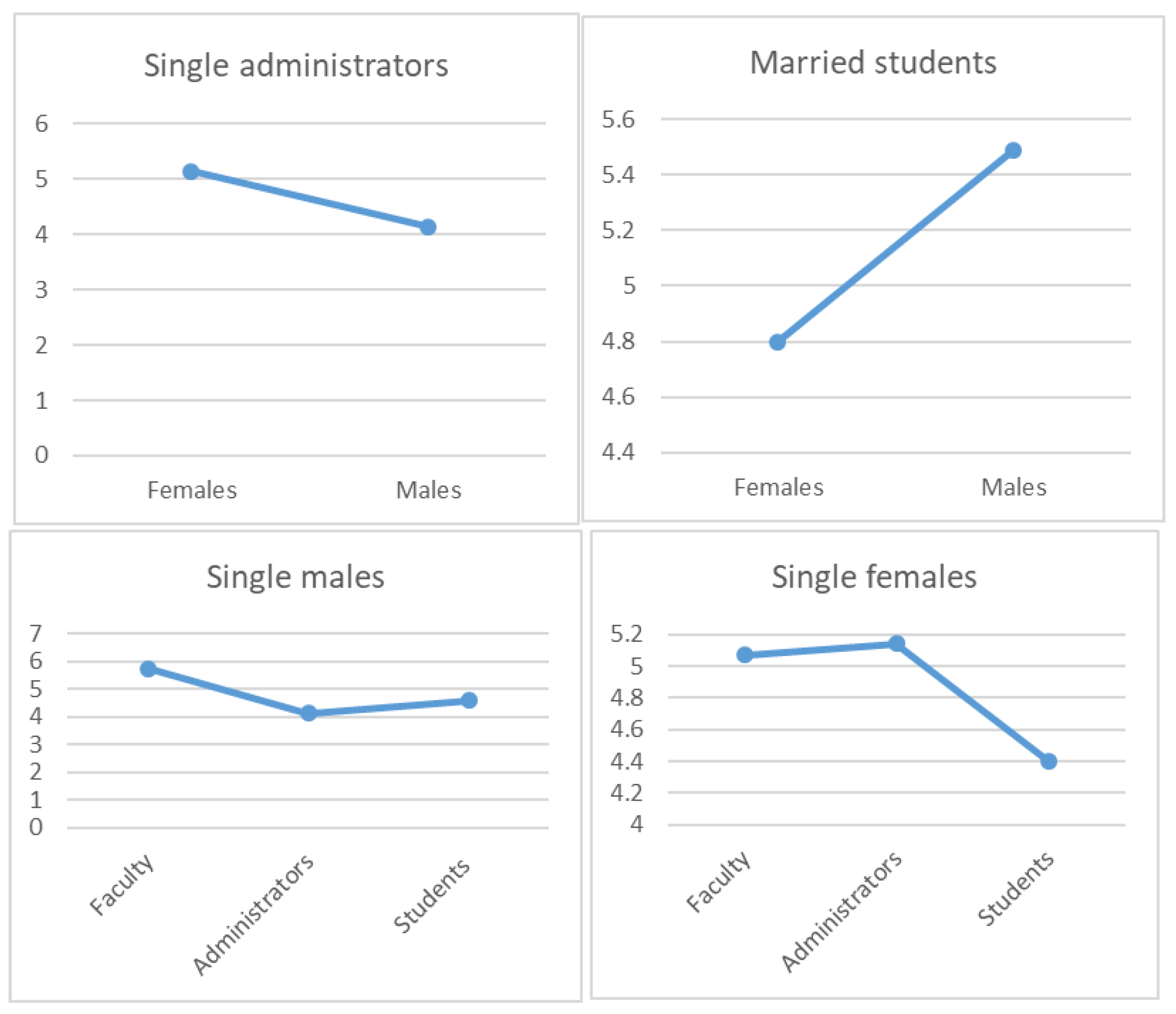Exploring Emotional Intelligence and Sociodemographics in Higher Education; the Imperative for Skills and Curriculum Development
Abstract
:1. Introduction
2. Materials and Methods
2.1. Ethical Approval
2.2. Design
2.3. Population and Sampling
2.4. Procedure and Instrument
2.5. Data Analysis
3. Results
3.1. Study Population
3.2. Univariable Analysis
4. Discussion
5. Conclusions
Supplementary Materials
Author Contributions
Funding
Institutional Review Board Statement
Informed Consent Statement
Data Availability Statement
Conflicts of Interest
References
- Fiori, M.; Vesely-Maillefer, A.K. Emotional intelligence as an ability: Theory, challenges, and new directions. In Emotional Intelligence in Education; Springer: Cham, Switzerland, 2018; pp. 23–47. [Google Scholar]
- Siegling, A.B.; Furnham, A.; Petrides, K.V. Trait emotional intelligence and personality: Gender-invariant linkages across different measures of the Big Five. J. Psychoeduc. Assess. 2015, 33, 57–67. [Google Scholar] [CrossRef] [PubMed]
- Stami, T.; Ritin, F.; Dominique, P. Demographic predictors of emotional intelligence among radiation therapists. J. Med. Radiat. Sci. 2018, 65, 114–122. [Google Scholar] [CrossRef] [PubMed]
- Petrides, K.V.; Mikolajczak, M.; Mavroveli, S.; Sanchez-Ruiz, M.-J.; Furnham, A.; Pérez-González, J.-C. Developments in trait emotional intelligence research. Emot. Rev. 2016, 8, 335–341. [Google Scholar] [CrossRef]
- Mayer, J.D.; Caruso, D.R.; Panter, A.T.; Salovey, P. The growing significance of hot intelligences. Am. Psychol. 2012, 67, 502–503. [Google Scholar] [CrossRef] [PubMed]
- Gutiérrez-Cobo, M.J.; Cabello, R.; Fernández-Berrocal, P. The three models of emotional intelligence and performance in a hot and cool go/no-go task in undergraduate students. Front. Behav. Neurosci. 2017, 11, 33. [Google Scholar] [CrossRef]
- Gillioz, C.; Nicolet-Dit-Felix, M.; Fiori, M. Emotional Intelligence and Emotional Hypersensitivity in Gifted Individuals. J. Intell. 2023, 11, 20. [Google Scholar] [CrossRef]
- Lopes, P.N. Emotional Intelligence in Organizations: Bridging Research and Practice. Emot. Rev. 2016, 8, 316–321. [Google Scholar] [CrossRef]
- Bru-Luna, L.M.; Marti-Vilar, M.; Merino-Soto, C.; Cervera-Santiago, J.L. Emotional Intelligence Measures: A Systematic Review. Healthcare 2021, 9, 1696. [Google Scholar] [CrossRef]
- Vanuk, J.R.; Alkozei, A.; Raikes, A.C.; Allen, J.J.; Killgore, W.D. Ability-based emotional intelligence is associated with greater cardiac vagal control and reactivity. Front. Hum. Neurosci. 2019, 13, 181. [Google Scholar] [CrossRef]
- Pérez-González, J.-C.; Saklofske, D.H.; Mavroveli, S. Editorial: Trait Emotional Intelligence: Foundations, Assessment, and Education. Front. Psychol. 2020, 11, 608. [Google Scholar] [CrossRef]
- Siegling, A.B.; Saklofske, D.H.; Petrides, K. Measures of ability and trait emotional intelligence. In Measures of Personality and Social Psychological Constructs; Academic Press: Cambridge, MA, USA, 2015; pp. 381–414. [Google Scholar]
- Thomas, C.L.; Allen, K. Driving engagement: Investigating the influence of emotional intelligence and academic buoyancy on student engagement. J. Furth. High. Educ. 2021, 45, 107–119. [Google Scholar] [CrossRef]
- Alsharari, N.M.; Alshurideh, M.T. Student retention in higher education: The role of creativity, emotional intelligence and learner autonomy. Int. J. Educ. Manag. 2021, 35, 233–247. [Google Scholar] [CrossRef]
- Hsu, N.; Newman, D.A.; Badura, K.L. Emotional Intelligence and Transformational Leadership: Meta-Analysis and Explanatory Model of Female Leadership Advantage. J. Intell. 2022, 10, 104. [Google Scholar] [CrossRef] [PubMed]
- Supramaniam, S.; Singaravelloo, K. Impact of emotional intelligence on organisational performance: An analysis in the Malaysian Public Administration. Adm. Sci. 2021, 11, 76. [Google Scholar] [CrossRef]
- Doan, T.T.T.; Nguyen, L.C.T.; Nguyen, T.D.N. Emotional intelligence and project success: The roles of transformational leadership and organizational commitment. J. Asian Financ. Econ. Bus. 2020, 7, 223–233. [Google Scholar] [CrossRef]
- Petrides, K.V. Psychometric properties of the trait emotional intelligence questionnaire (TEIQue). In Assessing Emotional Intelligence; Springer: Boston, MA, USA, 2009; pp. 85–101. [Google Scholar]
- Basu, A.; Mermillod, M. Emotional intelligence and social-emotional learning: An overview. Online Submiss. 2011, 1, 182–185. [Google Scholar]
- Al Huseini, S.; Al Alawi, M.; Al Sinawi, H.; Al-Balushi, N.; Jose, S.; Al-Adawi, S. Trait Emotional Intelligence and Its Correlates in Oman Medical Specialty Board Residents. J. Grad. Med. Educ. 2019, 11 (Suppl. S4), 134–140. [Google Scholar] [CrossRef]
- Alam, K.K. Emotional intelligence and anxiety, stress, and depression in first phase medical undergraduates. Asian J. Med. Sci. 2023, 14, 234–240. [Google Scholar] [CrossRef]
- Al-Dassean, K.A. Psychometric properties of the Arabic version of the Trait Emotional Intelligence Questionnaire Short Form (TEIQue-SF). Cogent Psychol. 2023, 10, 2171184. [Google Scholar] [CrossRef]
- Christodoulakis, A.; Kritsotakis, G.; Gkorezis, P.; Sourtzi, P.; Tsiligianni, I. Linking Learning Environment and Critical Thinking through Emotional Intelligence: A Cross-Sectional Study of Health Sciences Students. Healthcare 2023, 11, 826. [Google Scholar] [PubMed]
- McKenna, J.; Webb, J.A.; Weinberg, A. A UK-wide analysis of trait emotional intelligence in occupational therapists. Int. J. Ther. Rehabil. 2020, 27, 1–13. [Google Scholar] [CrossRef]
- Stiglic, G.; Cilar, L.; Novak, Z.; Vrbnjak, D.; Stenhouse, R.; Snowden, A.; Pajnkihar, M. Emotional intelligence among nursing students: Findings from a cross-sectional study. Nurse Educ. Today 2018, 66, 33–38. [Google Scholar] [CrossRef] [PubMed]
- Pau, A.K.; Croucher, R. Emotional intelligence and perceived stress in dental undergraduates. J. Dent. Educ. 2003, 67, 1023–1028. [Google Scholar] [CrossRef]
- Nasiri Zarch, Z.; Marashi, S.M.; Raji, H. The Relationship between Emotional Intelligence and Marital Satisfaction: 10-Year Outcome of Partners from Three Different Economic Levels. Iran. J. Psychiatry 2014, 9, 188–196. [Google Scholar]
- Chen, Y.; Peng, Y.; Fang, P. Emotional intelligence mediates the relationship between age and subjective well-being. Int. J. Aging Hum. Dev. 2016, 83, 91–107. [Google Scholar] [CrossRef]
- Skurvydas, A.; Lisinskiene, A.; Lochbaum, M.; Majauskiene, D.; Valanciene, D.; Dadeliene, R.; Fatkulina, N.; Sarkauskiene, A. Physical activity, stress, depression, emotional intelligence, logical thinking, and overall health in a large Lithuanian from October 2019 to June 2020: Age and gender differences adult sample. Int. J. Environ. Res. Public Health 2021, 18, 12809. [Google Scholar] [CrossRef]
- Abe, K.; Niwa, M.; Fujisaki, K.; Suzuki, Y. Associations between emotional intelligence, empathy and personality in Japanese medical students. BMC Med. Educ. 2018, 18, 47. [Google Scholar] [CrossRef]
- Najimi, A.; Doustmohamadi, P.; Omid, A. The relationship between emotional intelligence, social responsibility, and job performance in health service providers. J. Educ. Health Promot. 2021, 10, 126. [Google Scholar]
- Tsaousis, I.; Kazi, S. Factorial invariance and latent mean differences of scores on trait emotional intelligence across gender and age. Personal. Individ. Differ. 2013, 54, 169–173. [Google Scholar] [CrossRef]
- Salguero, J.M.; Extremera, N.; Fernández-Berrocal, P. Emotional intelligence and depression: The moderator role of gender. Personal. Individ. Differ. 2012, 53, 29–32. [Google Scholar]
- Kaifi, B.A.; Noori, S.A. Organizational Management: A Study on Middle Managers, Gender, and Emotional Intelligence Levels. 2010. Available online: https://ssrn.com/abstract=1627835 (accessed on 1 February 2022).
- Lopez-Zafra, E.; Gartzia, L. Perceptions of gender differences in self-report measures of emotional intelligence. Sex Roles 2014, 70, 479–495. [Google Scholar]
- Meshkat, M.; Nejati, R. Does emotional intelligence depend on gender? A study on undergraduate English majors of three Iranian universities. SAGE Open 2017, 7, 2158244017725796. [Google Scholar]
- Ajmal, S.; Javed, S.; Javed, H. Gender differences in emotional intelligence among medical students. Int. J. Bus. Soc. Sci. 2017, 8, 205–207. [Google Scholar]
- Ahmad, S.; Bangash, H.; Khan, S.A. Emotional intelligence and gender differences. Sarhad J. Agric. 2009, 25, 127–130. [Google Scholar]
- Shahzad, S.; Bagum, N. Gender differences in trait emotional intelligence: A comparative study. Bus. Rev. 2012, 7, 106–112. [Google Scholar] [CrossRef]
- Khalili, A. Gender differences in emotional intelligence among employees of small and medium enterprise: An empirical study. J. Int. Manag. Stud. 2011, 6, 184–193. [Google Scholar]
- Chen, X.; Cheng, L. Emotional Intelligence and Creative Self-Efficacy among Gifted Children: Mediating Effect of Self-Esteem and Moderating Effect of Gender. J. Intell. 2023, 11, 17. [Google Scholar]
- El Badawy, T.A.; Magdy, M.M. Assessing the impact of emotional intelligence on job satisfaction: An empirical study on faculty members with respect to gender and age. Int. Bus. Res. 2015, 8, 67. [Google Scholar] [CrossRef]
- Arteche, A.; Chamorro-Premuzic, T.; Furnham, A.; Crump, J. The relationship of trait EI with personality, IQ and sex in a UK sample of employees. Int. J. Sel. Assess. 2008, 16, 421–426. [Google Scholar] [CrossRef]
- Serebrakian, A.T.; Petrusa, E.R.; McKinley, S.K.; Ortiz, R.; Austen, W.G.; Phitayakorn, R. Evaluating and comparing emotional intelligence and improvement mindset of plastic surgery residents. J. Surg. Res. 2021, 268, 750–756. [Google Scholar] [PubMed]
- McKinley, S.K.; Petrusa, E.R.; Fiedeldey-Van Dijk, C.; Mullen, J.T.; Smink, D.S.; Scott-Vernaglia, S.E.; Kent, T.S.; Black-Schaffer, W.S.; Phitayakorn, R. Are there gender differences in the emotional intelligence of resident physicians? J. Surg. Educ. 2014, 71, e33–e40. [Google Scholar] [PubMed]
- Depape, A.-M.R.; Hakim-Larson, J.; Voelker, S.; Page, S.; Jackson, D.L. Self-talk and emotional intelligence in university students. Can. J. Behav. Sci./Rev. Can. Sci. Comport. 2006, 38, 250–260. [Google Scholar] [CrossRef]
- Shahbazi, S.; Heidari, M.; Sureshjani, E.H.; Rezaei, P. Effects of problem-solving skill training on emotional intelligence of nursing students: An experimental study. J. Educ. Health Promot. 2018, 7, 156. [Google Scholar] [PubMed]
- Milani, A.S.; Hosseini, M.; Matbouei, M.; Nasiri, M. Effectiveness of emotional intelligence training program on marital satisfaction, sexual quality of life, and psychological well-being of women. J. Educ. Health Promot. 2020, 9, 149. [Google Scholar]
- Chandrapal, J.; Park, C.; Holtschneider, M.; Doty, J.; Taylor, D. Using Individual Assessments as a Tool for Formative Feedback on Emotional Intelligence Training Programs in Healthcare Learners. J. Med. Educ. Curric. Dev. 2022, 9, 23821205221079567. [Google Scholar] [CrossRef]
- Johnsen, J.A.K.; Borit, M.; Stangvaltaite-Mouhat, L. Using storytelling in undergraduate dental education: Students’ experiences of emotional competence training. Eur. J. Dent. Educ. 2023, 27, 793–801. [Google Scholar]
- Buckley, K.; Bowman, B.; Raney, E.; Afolabi, T.; Fettkether, R.M.; Larson, S.; Tennant, S.; Goodlet, K.J. Enhancing the emotional intelligence of student leaders within an accelerated pharmacy program. Am. J. Pharm. Educ. 2020, 84, 1476–1481. [Google Scholar]
- Caballero-García, P.A.; Sánchez Ruiz, S. Creativity and life satisfaction in spanish university students. Effects of an emotionally positive and creative program. Front. Psychol. 2021, 12, 746154. [Google Scholar]



| Variables | Number (%) | Variables | Number (%) |
|---|---|---|---|
| Gender | Position | ||
| Male | 141 (27.3) | Administrative staff | 98 (19) |
| Female | 376 (72.7) | Academic staff | 104 (20.1) |
| Age | Student | 315 (60.9) | |
| 18–34 | 380 (73.5) | Marital Status | |
| 35 and over | 137 (26.5) | Single | 349 (67.5) |
| Citizenship | Married | 168 (32.5) | |
| Qatari | 189 (36.6) | ||
| Non-Qatari | 328 (63.4) |
| Variables | Well-Being | Self-Control | Emotionality | Sociability | Global EI | |||||
|---|---|---|---|---|---|---|---|---|---|---|
| Mean ± SD | p-Value | Mean ± SD | p-Value | Mean ± SD | p-Value | Mean ± SD | p-Value | Mean ± SD | p-Value | |
| Gender | ||||||||||
| Male | 5.3 ± 1.01 | 0.071 | 4.6 ± 1.0 | 0.023 | 4.8 ± 0.97 | 0.8 | 4.7 ± 1.01 | 0.6 | 4.8 ± 0.75 | 0.473 |
| Female | 5.5 ± 1.05 | 4.4 ± 1.02 | 4.8 ± 1.05 | 4.7 ± 1.10 | 4.8 ± 0.80 | |||||
| Age | ||||||||||
| 18–24 | 5.3 ± 1.07 | 0.002 | 4.3 ± 1.00 | <0.001 | 4.6 ± 1.05 | <0.001 | 4.6 ± 1.12 | 0.05 | 4.7 ± 0.77 | <0.001 |
| 25–34 | 5.4 ± 1.03 | 4.4 ± 0.97 | 4.7 ± 0.97 | 4.6 ± 1.04 | 4.8 ± 0.76 | |||||
| 35–44 | 5.6 ± 1.02 | 4.7 ± 1.07 | 5.1 ± 0.97 | 4.9 ± 1.01 | 5.0 ± 0.78 | |||||
| 45–54 | 5.7 ± 0.84 | 4.8 ± 0.95 | 5.2 ± 0.88 | 4.9 ± 1.00 | 5.1 ± 0.70 | |||||
| ≥55 | 6.1 ± 0.91 | 5.1 ± 0.98 | 5.5 ± 0.88 | 5.2 ± 1.03 | 5.4 ± 0.78 | |||||
| Position | ||||||||||
| Student | 5.3 ± 1.06 | 0.020 | 4.3 ± 1.02 | <0.001 | 4.6 ± 1.04 | <0.001 | 4.6 ± 1.11 | 0.12 | 4.7 ± 0.77 | <0.001 |
| Administrative | 5.5 ± 1.08 | 4.7 ± 0.94 | 5.0 ± 0.97 | 4.9 ± 0.97 | 4.9 ± 0.76 | |||||
| Academic | 5.67 ± 0.93 | 4.79 ± 1.02 | 5.12 ± 0.94 | 4.81 ± 1.08 | 5.07 ± 0.78 | |||||
| Marital Status | ||||||||||
| Single | 5.34 ± 1.07 | 0.005 | 4.38 ± 1.00 | 0.045 | 4.65 ± 1.05 | <0.001 | 4.63 ± 1.10 | 0.022 | 4.71 ± 0.78 | <0.001 |
| Married | 5.61 ± 0.97 | 4.57 ± 1.06 | 5.05 ± 0.95 | 4.86 ± 1.01 | 4.98 ± 0.77 | |||||
| Effect | F | p-Value | ηp2 |
|---|---|---|---|
| Age | 4.147 | 0.042 | 0.008 |
| Gender | 0.008 | 0.929 | 0.000 |
| Position | 1.220 | 0.296 | 0.005 |
| Marital status | 0.350 | 0.554 | 0.001 |
| Age × gender | 0.166 | 0.684 | 0.000 |
| Age × position | 1.993 | 0.137 | 0.008 |
| Age × marital status | 1.646 | 0.200 | 0.003 |
| Gender × position | 3.952 | 0.020 | 0.016 |
| Gender × marital status | 0.958 | 0.328 | 0.002 |
| Position × marital | 3.435 | 0.033 | 0.014 |
| Age × gender × position | 4.364 | 0.013 | 0.017 |
| Age × gender × marital status | 7.127 | 0.008 | 0.014 |
| Age × position × marital status | 2.560 | 0.078 | 0.010 |
| Gender × position × marital status | 7.175 | 0.001 | 0.028 |
Disclaimer/Publisher’s Note: The statements, opinions and data contained in all publications are solely those of the individual author(s) and contributor(s) and not of MDPI and/or the editor(s). MDPI and/or the editor(s) disclaim responsibility for any injury to people or property resulting from any ideas, methods, instructions or products referred to in the content. |
© 2023 by the authors. Licensee MDPI, Basel, Switzerland. This article is an open access article distributed under the terms and conditions of the Creative Commons Attribution (CC BY) license (https://creativecommons.org/licenses/by/4.0/).
Share and Cite
Abouhasera, S.; Abu-Madi, M.; Al-Hamdani, M.; Abdallah, A.M. Exploring Emotional Intelligence and Sociodemographics in Higher Education; the Imperative for Skills and Curriculum Development. Behav. Sci. 2023, 13, 911. https://doi.org/10.3390/bs13110911
Abouhasera S, Abu-Madi M, Al-Hamdani M, Abdallah AM. Exploring Emotional Intelligence and Sociodemographics in Higher Education; the Imperative for Skills and Curriculum Development. Behavioral Sciences. 2023; 13(11):911. https://doi.org/10.3390/bs13110911
Chicago/Turabian StyleAbouhasera, Sanaa, Marawan Abu-Madi, Mohammed Al-Hamdani, and Atiyeh M. Abdallah. 2023. "Exploring Emotional Intelligence and Sociodemographics in Higher Education; the Imperative for Skills and Curriculum Development" Behavioral Sciences 13, no. 11: 911. https://doi.org/10.3390/bs13110911
APA StyleAbouhasera, S., Abu-Madi, M., Al-Hamdani, M., & Abdallah, A. M. (2023). Exploring Emotional Intelligence and Sociodemographics in Higher Education; the Imperative for Skills and Curriculum Development. Behavioral Sciences, 13(11), 911. https://doi.org/10.3390/bs13110911





